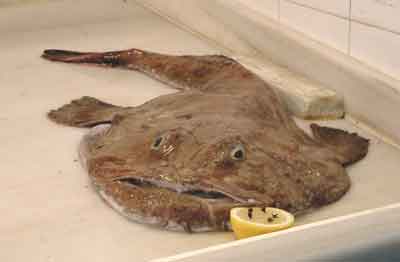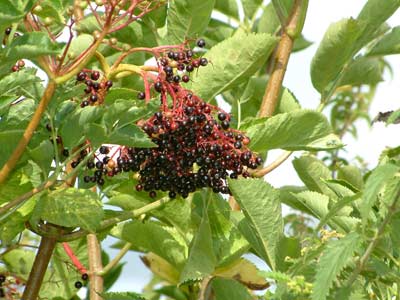Flat lobster. A variety of lobster with a flat tail, shaped somewhat like a slipper, which is the edible part. It makes a noise like a cricket. The Mediterranean slipper lobster is generally used for flavouring soups as it does not carry much meat.

Monkfish (US: angler fish). A fish with a sweet flavour and succulent firm flesh but with the ugliest appearance imaginable. It is found in the Mediterranean and Atlantic, in coastal waters of north western Europe. It can be recognised by its large head and fan-shaped fins. The fins and the operculum are spiny. It can be eaten fried or in soup. The larger fish often have better flavour. It has a hideous head, which is why it is usually displayed without it, and a muddy colour. It is known as the anglerfish as it bears on its head a 'rod' and 'lure' which attract its prey. The meat of the tail is sweet and succulent - almost like lobster meat, entirely compensating for is appearance. The flavour may well be assisted by its own diet which is high in shellfish. The best monkfish are Lophius piscatorius and the similar Lophius budegassa, the favourite of the Spanish. American monkfish or goosefish (Lophius americanus) is considered inferior, while New Zealand monkfish (Kathetostoma giganteum) is related to the stargazer and is only fit for soup.
Sapodilla. A fruit which can be round or oval. Its thin skin is slightly rough and the flesh is dull, beige to terra cotta in colour and slightly granular with flat black seeds. Peel the skin away to reveal the apricot-coloured, honey-flavoured flesh. If it is eaten slightly under-ripe it may leave a residue of gum in the mouth. This can be dispelled by eating something fatty or wiping the lips with butter. One variety provides the gum for chewing gum.
A name for black sapote. The fruit of a tall, handsome tree with black bark, native to Mexico and the forested lowlands of Central America and was carried to many parts of the world by the Spaniards. On the tree, the fruit is shiny bright green, ripening to a muddy green. The swet-flavoured flesh is glossy, very dark brown and jelly-like, surrounding anything from none to ten flat smooth seeds.
The fruit of a tall, handsome tree with black bark, native to Mexico and the forested lowlands of Central America and was carried to many parts of the world by the Spaniards. On the tree, the fruit is shiny bright green, ripening to a muddy green. The swet-flavoured flesh is glossy, very dark brown and jelly-like, surrounding anything from none to ten flat smooth seeds.

Elderberry. A tree which produces berries that are used for making syrups and wines, while the flowers are used for wine or cordials or may be dipped in batter and fried. Elderflowers are also a traditional accompaniment to gooseberries in crumbles. In France the flowers may also be used to flavour a confection. Folklore has it that elderberries gathered on St John's Eve (23rd June) protect against witchcraft. I am not sure I have ever seen an elderberry ripe for picking so early in the year. The dried berries can be used as a substitute for raisins.